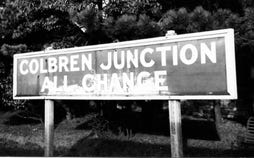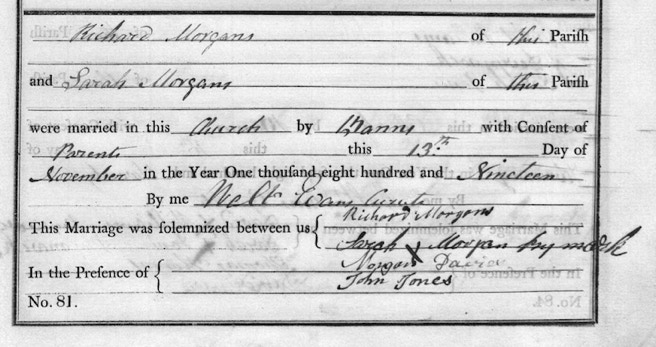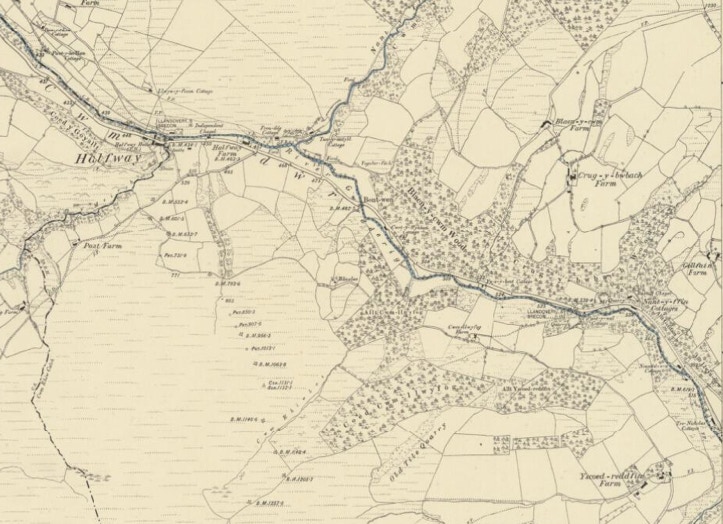Richard Morgans was baptised at Llywel on 30th June 1798. His father is recorded in the parish record as ‘farmer in Cwndwr, Trayanmawr.’
Twenty three years later, a couple, Richard Morgans and a Sarah Morgans were married at Llywel St David’s Parish Church on the 19th November 1819. They were young, most probably under 21, as the marriage is noted “with the consent of parents” and were both of the parish (of Llywel). If under 21, it was not strictly necessary to have the active consent of parents, if Banns had been read, which, in this case they had been on three preceding Sundays.
Above: extract of the marriage record book for St David’s Church, Llywel, 1819. Richard Morgans was able to sign his own name, indicating quite unusual literacy at this time.
Richard’s father, Morgan Richard Morgan, is likely to have been a tenant farmer, probably at Gellfain, just off the course of today’s A40. The young Richard may have met Sarah at one of the many fairs or markets that would have been held in Trecastle, for as much social as commercial purposes. Whether or not the union of these two young people would have received the approval of both sets of parents, in the normal course of things, is however perhaps debatable (I am grateful to Lynne Davies for this interpretation). Sarah’s parents owned Llwynynn - inherited through her mother - a prominent farm quite close to Castell Ddu and were well-known local Methodists. Sarah’s grandparents, for example, Ann David and Llewelyn Morgans, were “a devoted couple renowned for their hospitality, and for their leadership of the nonconforming community. Llewelyn, the “Exhorter” died aged 47 whilst conducting a meeting at Builth, and was carried by relays of bearers to Llywel where he was buried following a service which was attended by the largest body of mourners ever known at Llywel Church (24 March 1783).”(from Evans, 1988). It is therefore likely they attached great importance to notions of propriety and respectability in respect of Biblical teaching on family life. But Sarah Morgans was the couple’s youngest daughter of six children (indeed her mother Ann died six months after her birth in November 1797 at the age of 33) and perhaps felt herself sufficiently distant from such convention.
The issue was that Richard and Sarah’s marriage in the autumn of 1819 was not the first time this couple appears to have been recorded at Llywel by Curate W. Evans. Almost exactly one month before the wedding , the baptism of Morgan Morgans, to parents Richard Morgans and Sarah Morgans of the local hamlet of Trayan Glas is recorded and we can thus probably now discern the reason for the couple’s early marriage.
Extract from Llywel Baptism Records, October 1819
Ever scrupulous, and despite Sarah’s parents’ position and influence in the community, the curate dutifully records forever the unhappy circumstances of Morgan’s birth. We know that mother Sarah played no further part in the affairs of her parents’ farm at Llwyn-ynn and it appears the couple settled at Richard’s family home of Gellfain.
Extract from OS Map 0f 1888, six inches: one mile: Gellfain aius shown on the right. Neighbouring farms, Yscoed-ddreffin and Crug-y-bwbach would also feature in this family.
So far, three children have been linked to Richard and Sarah: the above-mentioned Morgan (1819), then Anne (1826) and Richard (1828). We know, for example, that Gwenllian Walters’ family Bible (see appendix) states that her husband Richard Morgans, born on October 8, 1828, was the son of “Richard and Sarah Morgans, Gelfain.” This will be the “Gellfain Farm” shown at the middle right on the map above. This is confirmed in his later 1903 obituary, the information probably reliably provided by his widow, Gwenllian. The nearest village, Halfway, is on the road (today’s A40) between Brecon and Llandovery. Two of the farms also shown on this map extract – Yscoed-dreffin and Crug-y-bwbach – would become associated with later Morgan generations. Generally, this map shows the Trayan Mawr area.
There may well have been more children, but for some reason Morgan is the only one to appear in the Parish Register for Llywel, and nor can any more for this couple be found in adjoining parishes e.g. Llandovery. Why do no birth records exist for these individuals? Here we run into a major brick wall in Welsh family history research: the fact that many of our ancestors were non-conformist and that records from these various denominations were either not kept or did not survive as well as those held by the established Church. It is very probable that Richard and Sarah Morgans were Baptist (non-conformist), and while before 1835 they were obliged by law to marry in the established parish church there was no such obligation to register births there. In fact, prior to compulsory civil registration in 1837, there was no legal obligation to register births anywhere. Nevertheless, some non-conformist parents did choose to have their children baptised in the parish church, if only to confer some official record of age on the child, the church at this time also fulfilling the role of secular public administrator. However, more problematically for us in a historical sense, if Richard’s parents were not only non-conformist, but also practising Baptists, like their later descendants, Richard would not have been baptised anywhere as an infant, and hence no record should be expected to exist for him. Some Baptist denominations did keep records of births among their congregations, but many did not. We have to accept that some Baptist children have no record of birth at all. If this is the reason, then we have to conjecture for the moment that this couple became practising Baptists sometime after their marriage in 1819. It is certainly clear that this family were well connected with the nearby Horeb Chapel.
About four years after Richard Morgan’s 1828 birth, on the 6th September 1832, Sarah Morgans, now described as a widow, married David Davies at Llywel Parish Church, and regardless of their religious conviction, they would have been obliged to marry in this church at this time. The marriage implies that Sarah’s first and apparently hasty marriage came to an end with the death of Richard Morgans sometime prior to September 1832, in his early 30s. No such record of death can so far be found for him, but again, pre-1837, only churches kept death records and if Richard was buried in a Baptist or other non-conformist chapel, again the available records are much sparser.
The newly constituted Davies family is then shown at Cerigydwr in the 1841 census, with two of Sarah’s children: Anne Morgans (15) and Richard Morgans (13).
1841 census for England and Wales: Parish of “Llywell", hamlet of Train-glas, settlement of “Cerig-y-dwr”.
Cerig-y-dwr is the settlement shown immediately southeast of Llywel, on the road to Trecastle on the 1905 map and matches the other settlements enumerated nearby on the census. This would be the home of the new Davies family for the next fifty years and Sarah Morgans (now Davies) lived there with her daughter, son-in-law John Williams and grandchildren until her death at the impressive age of 93 in 1889.
For our present purpose, we are most interested in the progress of Richard Morgans (1828-1903) but it is worth first tracing briefly the descendants of his known brother and sister.





